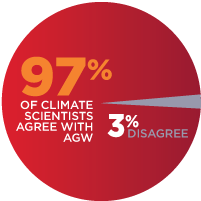Straw man: crushing concocted canards
| A debater seems to knock down his opponent’s argument with ease: expertise or red flag? |
How to recognise this tactic
When this tactic is used, it’s always in response to an argument put up by an opponent. Unable to come up with a reasoned response, the perpetrator constructs a distorted, incorrect version (the “straw man”) of the opponent’s argument, and then proceeds to tear it to shreds. The aim is to convince you that the original argument has been destroyed, when really it’s been ignored.
In the Straw Man approach, one attributes to an opponent a position as easily defeated as a dummy made of straw. The opponent may not even hold the position; or if he does, it may be so trivial as to make no difference to the argument. “I will believe in evolution when a monkey gives birth to a human baby!”
James Lawrence Powell, American geochemist, 2011
Why do people use this tactic?
People use this tactic to distract you from an argument that they can’t answer. This may be because the argument is too persuasive, or too powerful, but it may be simply that they don’t have the knowledge or reasoning power to address it. They substitute a weaker argument that may appear superficially to be similar, in the hope that you will be fooled into believing they have picked holes in the original.
What’s wrong with this tactic
It’s dishonest. Those who use straw men are not prepared to admit that they can’t fault their opponent’s argument. This doesn’t necessarily mean the argument is correct, but the honest response would be to admit that they don’t have the ammunition to refute it.
What to do when confronted by this tactic
You need to be alert to catch a straw man. The unannounced switch from real argument to bogus can catch you unaware and you can be sucked in. Be on the lookout for sweeping statements. And watch for responses that are supremely confident, seeming to demonstrate unusual command of the subject. This may indicate that the perpetrators are arguing against a concocted set of ideas rather than those of their opponents. When you detect a straw man, insist that the perpetrator abandon it and address the actual arguments of his opponents.
Variations and related tactics
A straw man is a type of red herring. In this case, the distracting argument bears a superficial resemblance to the original. In inventing straw men, other logical fallacies and cognitive biases are often employed. Some of the common ones are ad hominem, conspiracy theories, false dichotomy and rooster syndrome. One of the more extreme situations is described by Godwin’s Law – in any discussion, someone eventually resorts to comparisons with Hitler or Nazis.
Examples
- Here‘s a straw man being used in a debate about the teaching of CAM in universities. First, a group of scientists argues that universities should not offer health-related courses that lack an evidence base. A medical academic responds, throwing up a straw man by accusing the group of wanting to shut down the debate about alternative medicine.
- A common straw man employed by climate change deniers alleges a conspiracy amongst climate scientists. This tactic can be used against just about any argument because it implies that the proposer can’t be trusted, therefore the argument is faulty. It makes use of both conspiracy theories and ad hominem attacks, and is usually ‘knocked down’ by referring to “Climategate”. There is, of course, no evidence for a global conspiracy among climate scientists, and at least nine independent investigations have found no evidence of misconduct in “Climategate”.
- Creationists persist in using Hoyle’s fallacy as a straw man to attack the evolutionary model. Astronomer Fred Hoyle claimed that the likelihood of complex organisms evolving purely by chance was similar to the likelihood of a tornado ripping through a junkyard and leaving a fully assembled Boeing 747 in its wake. The fallacy in this argument is that evolution does not proceed through pure chance, but via the mechanism of natural selection.
- Here‘s another straw man used in a climate change debate. One commentator states that “human activity is accelerating dangerous changes in the world’s climate.” Another commentator responds by saying that “it is not clear that human activity is wholly responsible”. The second commentator has constructed a straw man because the first did not claim that human activity is wholly responsible, merely that it is accelerating the change.
James Lawrence Powell’s quote is from The Inquisition of Climate Science, Columbia University Press, New York.
The Straw Man cartoon is by MacLeod.
| This is one of ScienceOrNot’s Science red flags. See them all here. |










Nice one Graham. I have had numerous straw men thrust at me (and been falsely accused of setting them up myself) but, as you say, this is usually because the other person cannot – or does not want to – address the point made.
The latter happens to me a lot. Most often this is because I am refusing to get drawn into unwinable arguments about whose science is ‘junk’ and whose is ‘sound’ (what Peter Jacques calls ‘the science trap’). However, most often, people pedantically pick-over my previous pronouncements pathetically positing personal dishonesty.